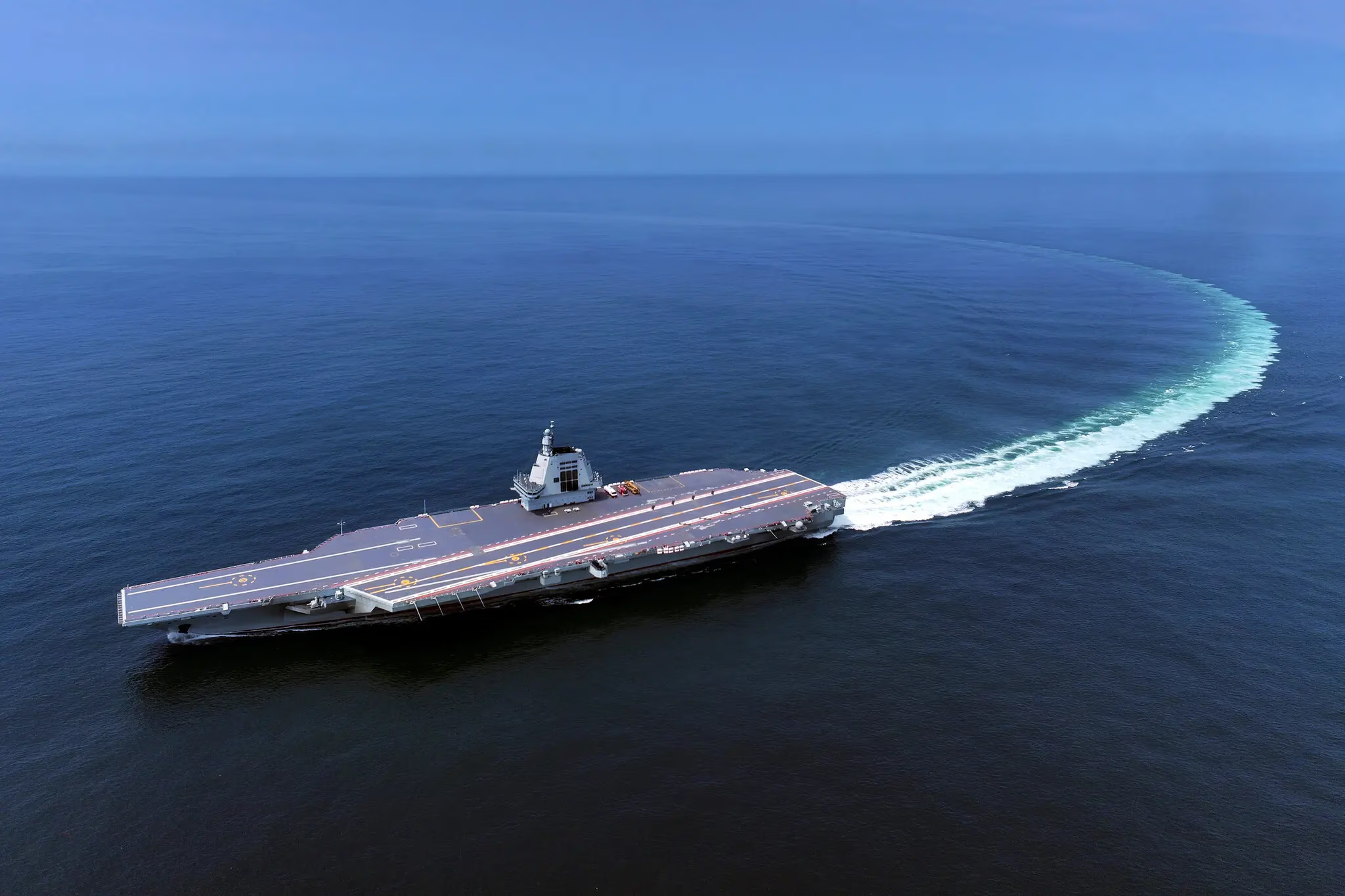China’s newest and most technologically advanced aircraft carrier, the Fujian, has officially entered service, the country’s defense ministry announced Friday. The move brings Beijing closer to its goal of matching U.S. naval power in the Asia-Pacific region.
According to Liberation Army Daily and other state media, the commissioning ceremony took place Wednesday on the southern island of Hainan under the supervision of President Xi Jinping. The ship is equipped with an electromagnetic catapult system for aircraft launch and recovery—a technology that, according to Chinese sources, Xi “personally approved” for installation despite its complexity and demanding requirements.
In footage released by official media, Xi Jinping, dressed in military uniform, is seen walking the ship’s deck, inspecting aviation equipment, and greeting pilots, calling them heroes.
Experts say the Fujian’s commissioning and China’s plans to build additional carriers demonstrate Beijing’s intent to assert military dominance in the western Pacific. These vessels serve as tools of power projection and political pressure. The Fujian is China’s third aircraft carrier and its most ambitious naval project to date. It was launched in 2022, but full operational readiness took several years to achieve.
In terms of numbers and capabilities, Chinese aircraft carriers still lag behind their American counterparts. China has three, all conventionally powered, while the United States operates eleven, all nuclear-powered. However, the Fujian is the first Chinese carrier to approach U.S. models in size and capability.
Satellite imagery indicates that construction of a fourth Chinese aircraft carrier is already underway. Plans for further fleet expansion are being discussed, and over time the country may shift to nuclear propulsion—despite arguments from those who believe the rise of drones and precision missiles makes such ships increasingly vulnerable.
“Although unmanned technologies are gaining importance, I don’t believe they will pose a serious threat to aircraft carriers within the next decade,” said Chiang Hsin-piao, a researcher at Taiwan’s Institute for National Defense and Security Research, funded by the Ministry of Defense. “Even the United States continues to build new carriers, which confirms their enduring value. The threats are relative and exist for both sides—China and the U.S.”
The public attention surrounding the Fujian’s commissioning may also serve as a political gesture by Xi Jinping following recent revelations of corruption in the top ranks of the People’s Liberation Army. In October, authorities announced the suspension and prosecution of nine senior officers, including General He Weidong, who ranked third in the military hierarchy after Xi and another top commander.
The Fujian’s main technological breakthrough is its electromagnetic catapult, which enables aircraft to take off and land. Its design is similar to the system installed on the U.S. aircraft carrier Gerald R. Ford—the first of the Navy’s newest generation of carriers. However, late last month Donald Trump criticized the technology as unreliable, saying that if he could, he would return American carriers to steam-powered catapults.
“When we build aircraft carriers, catapults should run on steam and elevators on hydraulics. That way, there will be no problems, understood?” Trump said during a visit to the U.S. aircraft carrier George Washington, stationed in Japan.
China’s two previous carriers—the Liaoning and the Shandong—use a simpler takeoff and landing system with ski-jump decks. The new technology on the Fujian allows for the launch of larger aircraft with heavier payloads and makes the process faster and less taxing on airframes.
The Fujian’s commissioning coincides with continued tension between China and Taiwan—the democratic island that rejects Beijing’s sovereignty claims. Analysts say China could deploy the new carrier as part of strike groups that include destroyers and submarines to increase pressure on Taiwan or other countries with territorial disputes with Beijing, particularly in the South China Sea.
Although aircraft carriers are unlikely to play a central role in a potential military operation against Taiwan—the island lies too close to mainland China and is protected by a dense network of air bases—some experts believe Beijing could eventually use them to enforce a maritime blockade.
“These carriers are certainly not designed solely for operations against Taiwan,” noted Chiang Hsin-piao. “But if deployed in the western Pacific, they could effectively encircle the island.”

"At Any Moment"—China Raises Readiness for Invasion of Taiwan
Air Force, Navy, and Paratroopers on High Alert

A Military Parade in Beijing Gathered China’s Allies and Showcased New Weapons
Xi Jinping Declared That the Country Will Not Accept U.S. Dictates and Warned Taiwan
Mastering the operation of large aircraft carriers far from home waters—and training crews to launch and recover numerous aircraft quickly—will take time for China’s navy. Still, Beijing has made clear its intent to accelerate the process. In September, China’s state military media released footage showing takeoff and landing drills aboard the Fujian.
Nevertheless, China still has a long way to go before becoming a true carrier power, said Aita Moriki, a research fellow at Japan’s National Institute for Defense Studies. In an analytical report published in early October, he emphasized: “Many technological and personnel challenges remain unresolved.”
